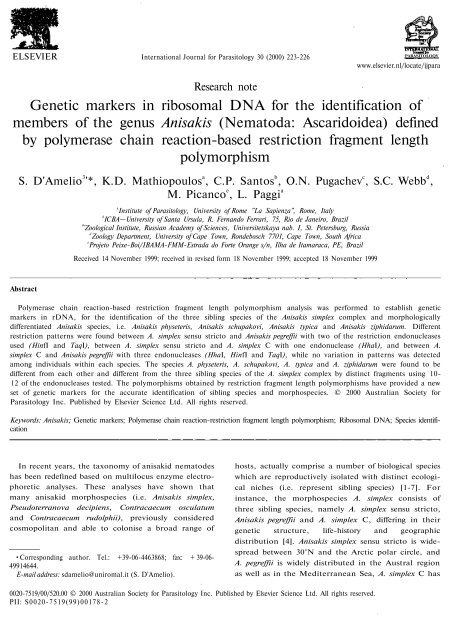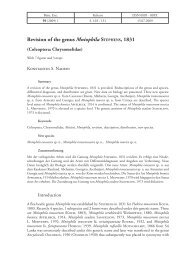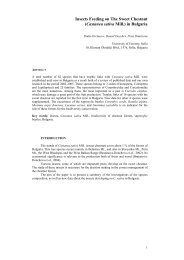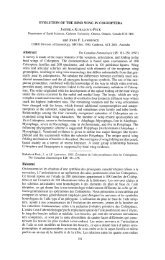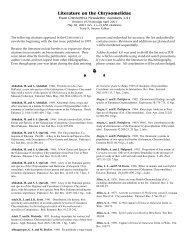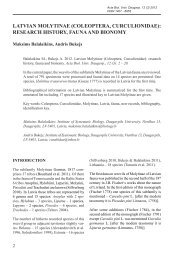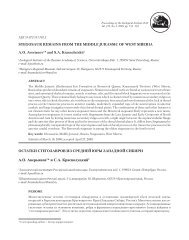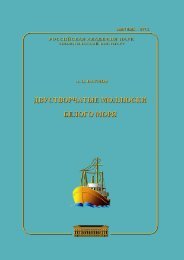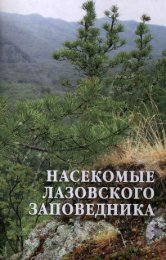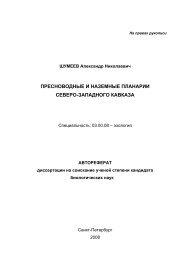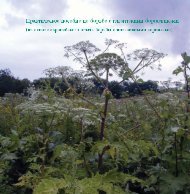Anisakis
Anisakis
Anisakis
- No tags were found...
You also want an ePaper? Increase the reach of your titles
YUMPU automatically turns print PDFs into web optimized ePapers that Google loves.
ELSEVIER International Journal for Parasitology 30 (2000) 223-226PARASITOLOQYwww.elsevier.nl/locate/ijparaResearch noteGenetic markers in ribosomal DNA for the identification ofmembers of the genus <strong>Anisakis</strong> (Nematoda: Ascaridoidea) definedby polymerase chain reaction-based restriction fragment lengthpolymorphismS. D'Amelio 3 '*, K.D. Mathiopoulos a , C.P. Santos b , O.N. Pugachev c , S.C. Webb d ,M. Picanco e , L. Paggi aaInstitute of Parasitology, University of Rome "La Sapienza", Rome, ItalybICBA—University of Santa Ursula, R. Fernando Ferrari, 75, Rio de Janeiro, Brazil1'Zoological Institute, Russian Academy of Sciences, Universitetskaya nab. I, St. Petersburg, RussiadZoology Department, University of Cape Town, Rondebosch 7701, Cape Town, South AfricaeProjeto Peixe-Boi/IBAMA-FMM-Estrada do Forte Orange s/n, Ilha de Itamaraca, PE, BrazilReceived 14 November 1999; received in revised form 18 November 1999; accepted 18 November 1999AbstractPolymerase chain reaction-based restriction fragment length polymorphism analysis was performed to establish geneticmarkers in rDNA, for the identification of the three sibling species of the <strong>Anisakis</strong> simplex complex and morphologicallydifferentiated <strong>Anisakis</strong> species, i.e. <strong>Anisakis</strong> physeteris, <strong>Anisakis</strong> schupakovi, <strong>Anisakis</strong> typica and <strong>Anisakis</strong> ziphidarum. Differentrestriction patterns were found between A. simplex sensu stricto and <strong>Anisakis</strong> pegreffii with two of the restriction endonucleasesused (HinfI and TaqI), between A. simplex sensu stricto and A. simplex С with one endonuclease (HhaI), and between A.simplex С and <strong>Anisakis</strong> pegreffii with three endonucleases (HhaI, HinfI and TaqI), while no variation in patterns was detectedamong individuals within each species. The species A. physeteris, A. schupakovi, A. typica and A. ziphidarum were found to bedifferent from each other and different from the three sibling species of the A. simplex complex by distinct fragments using 10-12 of the endonucleases tested. The polymorphisms obtained by restriction fragment length polymorphisms have provided a newset of genetic markers for the accurate identification of sibling species and morphospecies. © 2000 Australian Society forParasitology Inc. Published by Elsevier Science Ltd. All rights reserved.Keywords: <strong>Anisakis</strong>; Genetic markers; Polymerase chain reaction-restriction fragment length polymorphism; Ribosomal DNA; Species identificationIn recent years, the taxonomy of anisakid nematodeshas been redefined based on multilocus enzyme electrophoreticanalyses. These analyses have shown thatmany anisakid morphospecies (i.e. <strong>Anisakis</strong> simplex,Pseudoterranova decipiens, Contracaecum osculatumand Contracaecum rudolphii), previously consideredcosmopolitan and able to colonise a broad range of•Corresponding author. Tel.: +39-06-4463868; fax: + 39-06-49914644.E-mail address: sdamelio@uniromal.it (S. D'Amelio).hosts, actually comprise a number of biological specieswhich are reproductively isolated with distinct ecologicalniches (i.e. represent sibling species) [1-7]. Forinstance, the morphospecies A. simplex consists ofthree sibling species, namely A. simplex sensu stricto,<strong>Anisakis</strong> pegreffii and A. simplex C, differing in theirgenetic structure, life-history and geographicdistribution [4]. <strong>Anisakis</strong> simplex sensu stricto is widespreadbetween 30°N and the Arctic polar circle, andA. pegreffii is widely distributed in the Austral regionas well as in the Mediterranean Sea, A. simplex С has0020-7519/00/520.00 © 2000 Australian Society for Parasitology Inc. Published by Elsevier Science Ltd. All rights reserved.PII: S0020-7519(99)00178-2
224 S. D'Amelio et al. / International Journal for Parasitology 30 (2000) 223-226been found in the Canadian Pacific and in regionssouth of 35°S [4]. Multilocus enzyme electrophoreticanalyses have also allowed the genetic structure of<strong>Anisakis</strong> physeteris to be studied, thus providing geneticmarkers for the identification of larval formsbelonging to this species [3,8]. In addition these haveenabled a new species, <strong>Anisakis</strong> ziphidarum, to bedetected [9].The development of molecular markers for the accurateidentification of related species can be alsoachieved by using PCR-based approaches that haveshown a remarkable sensitivity in the detection of geneticvariation requiring only small amounts of fresh orethanol-fixed parasite material for analysis. Forexample, PCR-based restriction fragment length polymorphism(PCR-RFLP) analysis of the ribosomalDNA (rDNA) internal transcribed spacers (ITS-1 andITS-2) provides a useful approach for the specificidentification of both distantly and closely relatedascaridoid species, as these spacers showed high levelsof interspecific sequence differences in the presence oflow-level intraspecific variation [10].The aim of the present work was to exploit PCR-RFLP to establish genetic markers in rDNA for theidentification (irrespective of developmental stages) ofthe three sibling species of the A. simplex complex andanother four morphologically differentiated species of<strong>Anisakis</strong>, i.e. A. physeteris, a parasite of sperm whales,<strong>Anisakis</strong> typica, a parasite of cetaceans in warmwaters, A. ziphidarum, a parasite of cetaceans of thefamily Ziphiidae and <strong>Anisakis</strong> schupakovi, a parasite ofthe relict phocid species of the Caspian Sea, Phoca caspica.The latter species was considered as inquirendaeby Davey [11] in his revision of the genus <strong>Anisakis</strong>, butretained as a valid species by Kurochkin [12].Parasite species, number of specimens tested, geographicalorigins, life-cycle stages and hosts are listedin Table 1. For the three sibling species of the A. simplexcomplex, the study was conducted on specimenspreviously identified to the species level by multilocusenzyme electrophoresis.DNA extraction was performed, with minor modifications,according to the protocol proposed by Holmesand Bonner [13]. Each worm was placed in a 1.5 mlEppendorf tube and kept in liquid nitrogen for fewseconds to facilitate the rupture of cell membranes.The tissue was crushed by a pestle in 200 μl Holmes-Bonner buffer (urea 7 M, Tris-HCl 100 mM pH 8.0,EDTA 10 mM pH 8.0, NaCl 350 mM, SDS 2%).Subsequently, the DNA was purified with one phenolchloroformextraction, followed by two chloroformextractions and then an ethanol precipitation. The precipitatedpellet was resuspended in 100 μl ТЕ containingRNase. Two conserved primers A (forward):GTCGAATTCGTAGGTGAACCTGCGGAAGGAT-CA and B: GCCGGATCCGAATCCTGGTTA-GTTTCTTTTCCT [14] were used in PCR to amplifyan rDNA region (between the 3' end of the ssrRNAand the 5' end of the lsrRNA genes) using a standardbuffer (Perkin-Elmer) under the following conditions:10 min at 95°C, then 30 cycles of 30 s at 95°C, 30 s at55°C and 75 s at 72°C, followed by a final elongationof 7 min at 72°C. Amplicons were subjected to PCR-RFLP analysis using 16 individual restriction enzymes(AluI, DraI, EcoRI, EcoRV, Haelll, Hhal, HinfI,HpaII, Hsp92ll, MboI, NciI, PstI, PvuII, RsaI, SacIand TaqI) for all species under study.The amplification of the rDNA region (spanning theITS-1, ITS-2 and the 5.8S subunit) produced a fragmentof ~1 kb. Of the 16 restriction enzymes tested, 12cleaved the target sequence in one or more of thespecies under study, while four enzymes (DraI, EcoRV,PstI and SacI) did not. Different restriction patternswere produced between A. simplex sensu stricto and A.pegreffii using HinfIand TaqI, between A. simplex Сand A. pegreffii using HhaI, HinfI and TaqI andbetween A. simplex sensu stricto and A. simplex Сusing HhaI (Fig. 1), while no variation in RFLP patternswas observed among individuals within each ofTable 1The species of the genus <strong>Anisakis</strong> under study, with number of specimens tested (No.), geographic origin, life-cycle stage and hostsParasite Species No. Geographic origin Life stage a Host species<strong>Anisakis</strong> simplex s.s.<strong>Anisakis</strong> pegreffii<strong>Anisakis</strong> simplex С<strong>Anisakis</strong> physeteris<strong>Anisakis</strong> schupakovi<strong>Anisakis</strong> typica<strong>Anisakis</strong> ziphidarum855322512Pacific Canadian watersNorwegian watersTyrrhenian SeaTyrrhenian SeaPacific Canadian watersTyrrhenian SeaCaspian SeaBrazilian watersSouth African watersAAA bL3AAAAAPseudorca crassidensGlobicephala melaenaMicromesistius poutassouMicromesistius poutassouPseudorca crassidensPhyseter catodonPhoca caspicaStenella longirostrisZiphius cavirostrisaA = adults; L3 = third stage larvae.bAdults of A. pegreffii were obtained from in vitro culture.
S. D'Amelio et al. /International Journal for Parasitology 30 (2000) 223-2262251 2 3 4 5 6 7 LTable 2An example of taxonomic key based on two diagnostic restrictionenzymes (HhaI and HinfI) for the identification of species of thegenus <strong>Anisakis</strong>HhaI
226 S. D'Amelio et al. / International Journal for Parasitology 30 (2000) 223-226AcknowledgementsWe are grateful to Robin Gasser for helpful commentson the manuscript and to Ms Sandra Lijoi fortechnical assistance. The authors wish to thank DrIrine Podvyaznaya and Dr Konstantin Galkin for thecollection of material from the Caspian Sea. This workis co-supported by grants from Ministero per lePolitiche Agricole and from Ministero dell Universitae della Ricerca Scientifica e Tecnologica, Progetti diRilevante Interesse Nazionale-Cofinanziamento 1997.References[1] Nascetti G, Cianchi R, Mattiucci S et al. Three sibling specieswithin Contracaecum osculatum (Nematoda, Ascaridida,Ascaridoidea) from the Atlantic Arctic-boreal region: reproductiveisolation and host preferences. Int J Parasitol 1993;23:105-20.[2] Nascetti G, Paggi L, Orecchia P, Smith JW, Mattiucci S, BulliniL. Electrophoretic studies on the <strong>Anisakis</strong> simplex complex(Ascaridida: Anisakidae) from the Mediterranean and North-East Atlantic. Int J Parasitol 1986;16:633-40.[3] Mattiucci S, Nascetti G, Bullini L, Orecchia P, Paggi L. Geneticstructure of <strong>Anisakis</strong> physeteris and its differentiation from the<strong>Anisakis</strong> simplex complex (Ascaridida: Anisakidae). Parasitology1986;93:383-7.[4] Mattiucci S, Nascetti G, Cianchi R et al. Genetic and ecologicaldata on the <strong>Anisakis</strong> simplex complex with evidence for a newspecies (Nematoda Ascaridoidea, Anisakidae). J Parasitol1997;83:401-16.[5] D'Amelio S, Nascetti G, Mattiucci S et al. Ricerche elettroforetichesu alcune specie del genere Contracaecum parassite diuccelli ittiofagi (Ascaridida: Anisakidae). Parassitologia1990;32(suppl.l):77.[6] Paggi L, Nascetti G, Cianchi R et al. Genetic evidence for threespecies within Pseudoterranova decipiens (Nematoda,Ascaridida, Ascaridoidea) in the North Atlantic and Norwegianand Barents Seas. Int J Parasitol 1991;21:195-212.[7] Orecchia P, Mattiucci S, D'Amelio S et al. Two new membersin the Contracaecum osculatum complex (Nematoda:Ascaridoidea) from the Antarctic. Int J Parasitol 1994;24:367-77.[8] Orecchia P, Paggi L, Mattiucci S, Smith JW, Nascetti G, BulliniL. Electrophoretic identification of larvae and adults of <strong>Anisakis</strong>(Ascaridida: Anisakidae). J Helminthol 1986;60:331-9,[9] Paggi L, Nascetti G, Webb S, Mattiucci S, Cianchi R, BulliniL. A new species of <strong>Anisakis</strong> Dujardin, 1845 (NematodAAnisakidae) from beaked whales (Ziphiidae): allozyme and morphologicalevidence. Syst Parasitol 1998;40:161-74.[10] Zhu XQ, Gasser RB, Podolska M, Chilton NB.Characterisation of anisakid nematodes with zoonotic potentialby nuclear ribosomal DNA sequences. Int J Parasitol1999;28:1911-21.[11] Davey JT. A revision of the genus <strong>Anisakis</strong> Dujardin, 1875(Nematoda: Ascaridata). J Helminthol 1971;45:51-72.[12] Kurochkin YV. Parasites of the Caspian seal Pusa caspica.Rapport et proces-verbaux des reunion. Cons Int Expl Mer1975;169:363-5.[13] Holmes DS, Bonner J. Preparation, molecular weight, basecomposition, and secondary structure of giant nuclear ribonucleicacid. Biochemistry 1973;12(12):2330-8.[14] Bachellerie JP, Qu LU. Ribosomal RNA probes for detectionand identification of species. In: Hyde JE, editor. Protocols inmolecular parasitology 1993;249-63.


